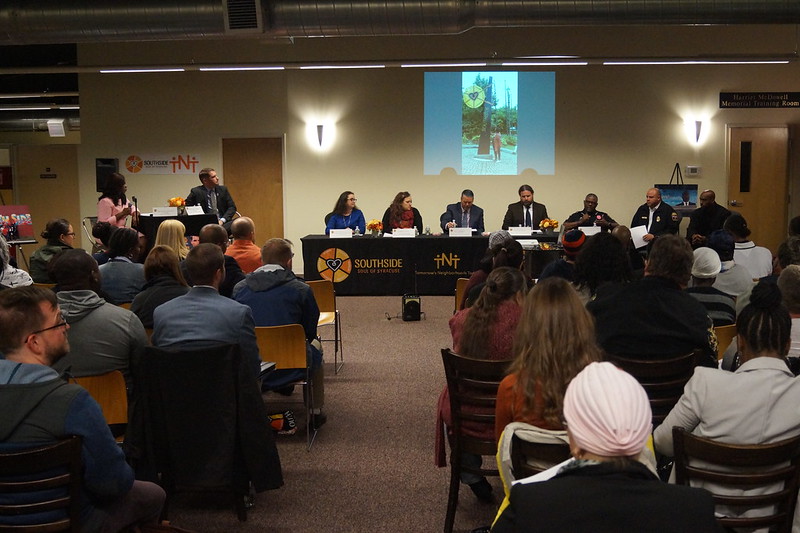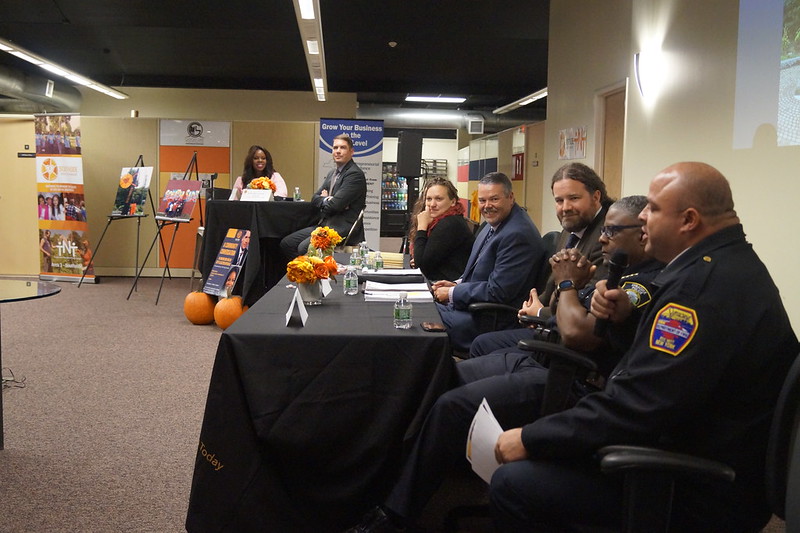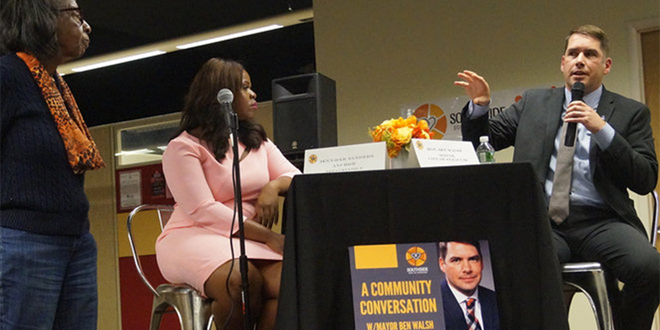Mayor Ben Walsh hopes that the city’s plans to expand the use of surveillance cameras and police-worn body cameras will help prevent shootings like the one that injured five people Sept. 20 on Midland Avenue.
Walsh made those comments Monday at a special Southside Tomorrow’s Neighborhood Today community meeting. The two-hour session at the South Side Innovation Center attracted more than 50 residents, along with Walsh and several members of his staff.
Topics covered included gun control, teen crime, Interstate 81 and education.
Angela Wright, chair of TNT’s voter education task force, began the discussion by introducing the organization, the panel members and the session’s moderator, Jennifer Sanders of NewsChannel 9.
The first question an audience member posed focused on the Midland Avenue shooting, which injured an 8-year-old girl, among others.
“That was a tough night,” Walsh said.
He said his administration is employing several tools and tactics to help prevent crime on the South Side and elsewhere in the city.
“We just announced our body-worn camera program, which we think will help build trust between the community and the police,” Walsh said. “We brought in three new deputy chiefs. The police department is working around the clock, making progress, and we are going to do everything we can to make sure we bring those responsible to justice.”

Because police Chief Frank Fowler plans to retire soon, Walsh said that the city has been on the lookout for someone to fill Fowler’s shoes. Walsh said the majority of the process thus far has been focused on community engagement. His administration has found such engagement has enhanced the search for a new police chief and has also helped strengthen community-police relations at a critical time.
“We are on target to bring in our new police chief before the end of the year,” Walsh said.
A new street light program that employs “smart lights” might also help fight crime, he added. When a street light goes out now, it doesn’t get fixed until someone reports it. A work order is then sent to National Grid, which repairs the light at its own convenience.
“With these new street lights, when a light goes out, somebody’s computer is going to flash,” Walsh said, explaining the entire process is automated. “We will be able to deploy resources to get that light back on as quickly as possible.”
He said the city will also have the technology to increase or dim the lighting based on specific neighborhood needs. “It really does change the game, just from a lighting standpoint,” Walsh said.
The new lighting program should also save city taxpayers $3 million a year, the mayor estimated.
Walsh also spoke about additional surveillance cameras on light poles, and the introduction of a “cloud” system that will allow instant information sharing across the entire city.
Based at least in part on community input, the city’s innovation team has picked sidewalks and housing stability as its main focus for the year.
“Twenty-five percent of city residents move at least once every year,” Walsh said. “No matter where you are in income spectrum, it’s a disruptive process.”
Walsh said his administration is looking at ways to help people stay in their homes and to equip residents to deal with unexpected problems.
Sidewalks are a problem, too, he said, noting “our sidewalks are in terrible condition.”
On I-81, Walsh said that the South Side will be disproportionately affected by whatever is decided for the future of the interstate. He said the tunnel option — where traffic from the surface streets would pass under the city — might be the least disruptive, but also the most expensive.
The existing elevated viaduct has to be torn down due to its age. Rebuilding it as an elevated roadway is not a viable option since a rebuilt 81 would have to be higher and wider, which would eventually lead to more disruption throughout the city, including property demolitions and resident relocations, the mayor said.
After the mayor spoke, Sanders invited other panel members to take the floor. Fowler spoke about a new reporting system between the police and the Syracuse City School District that encourages notification of crime or any traumatic experiences.
Fire Chief Michael Monds encouraged minorities to become firefighters, and talked about his mentorship program in city schools.

Sanders then opened the floor to the audience. Aggie Lane, a South Side resident, was the first to talk, describing her efforts to help stabilize jobs in marginalized communities. “We need electricians in the city. We need plumbers,” Lane said.
The mayor said he was hopeful his “Syracuse Build” initiative, a workforce development program, will help train community residents to take advantage of the jobs created by the I-81 project and other construction efforts in the city.
Pastor Phil Turner, an East Side resident, shared his thoughts on the increased gun access amongst young individuals. “I find it ludicrous to think that people’s behavior can be modified so that they don’t shoot guns,” he said.
To this, the mayor said that he has joined the national coalition Mayors Against Illegal Guns, which is working to stem the flow of guns into cities like Syracuse.
The mayor closed the discussion by talking about last year’s CNY Works youth employment program, which worked with more than 400 young people throughout the city in a collaboration between the city, county and state that led to the employment of more than 1,000 people this summer.
“You have given us a plan,” the mayor said. “Now it’s our responsibility, hand-in-hand with you, to implement.”
— Article and photos by Sajida Ayyup, The Stand Staff Reporter
 The Stand
The Stand


